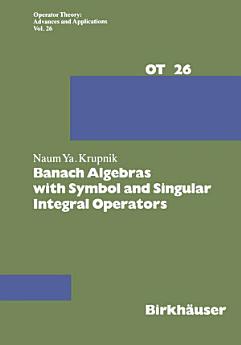Banach Algebras with Symbol and Singular Integral Operators
N. Krupnik
Nov 2013 · Operator Theory: Advances and Applications Book 26 · Birkhäuser
5.0star
1 reviewreport
Ebook
206
Pages
reportRatings and reviews aren’t verified Learn More
About this ebook
About fifty years aga S. G. Mikhlin, in solving the regularization problem for two-dimensional singular integral operators [56], assigned to each such operator a func tion which he called a symbol, and showed that regularization is possible if the infimum of the modulus of the symbol is positive. Later, the notion of a symbol was extended to multidimensional singular integral operators (of arbitrary dimension) [57, 58, 21, 22]. Subsequently, the synthesis of singular integral, and differential operators [2, 8, 9]led to the theory of pseudodifferential operators [17, 35] (see also [35(1)-35(17)]*), which are naturally characterized by their symbols. An important role in the construction of symbols for many classes of operators was played by Gelfand's theory of maximal ideals of Banach algebras [201. Using this the ory, criteria were obtained for Fredholmness of one-dimensional singular integral operators with continuous coefficients [34 (42)], Wiener-Hopf operators [37], and multidimensional singular integral operators [38 (2)]. The investigation of systems of equations involving such operators has led to the notion of matrix symbol [59, 12 (14), 39, 41]. This notion plays an essential role not only for systems, but also for singular integral operators with piecewise-continuous (scalar) coefficients [44 (4)]. At the same time, attempts to introduce a (scalar or matrix) symbol for other algebras have failed.
Ratings and reviews
5.0
1 review
Anil Das
- Flag inappropriate
February 21, 2021
AAA
Rate this ebook
Tell us what you think.
Reading information
Smartphones and tablets
Install the Google Play Books app for Android and iPad/iPhone. It syncs automatically with your account and allows you to read online or offline wherever you are.
Laptops and computers
You can listen to audiobooks purchased on Google Play using your computer's web browser.
eReaders and other devices
To read on e-ink devices like Kobo eReaders, you'll need to download a file and transfer it to your device. Follow the detailed Help Center instructions to transfer the files to supported eReaders.









